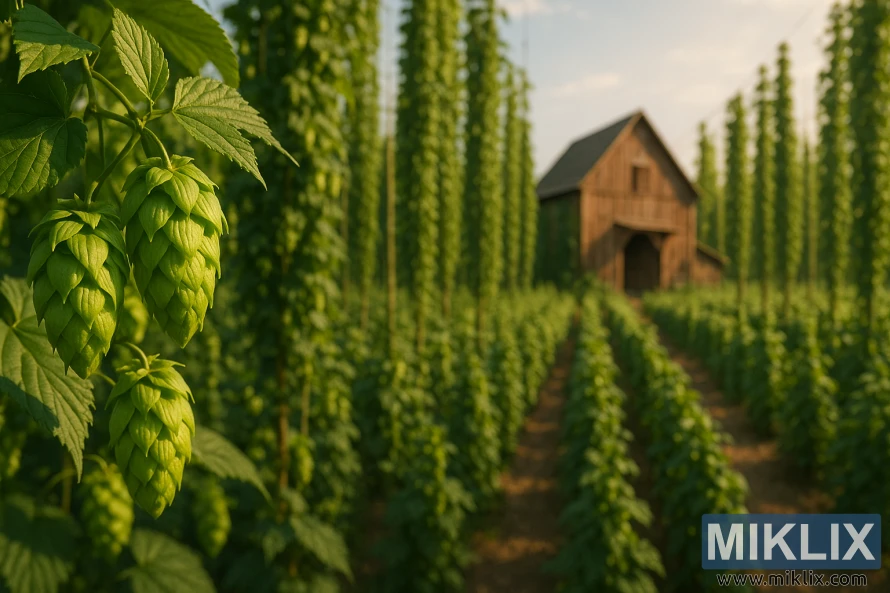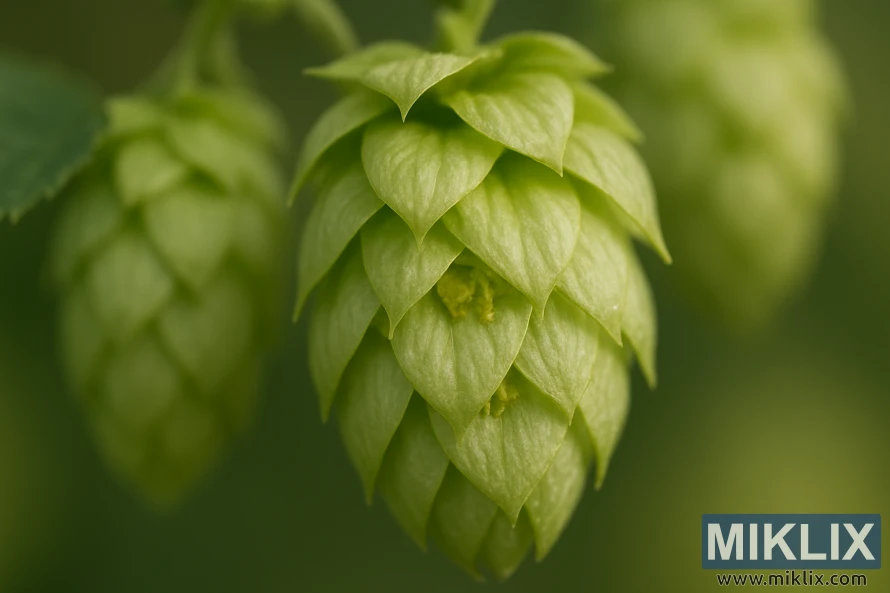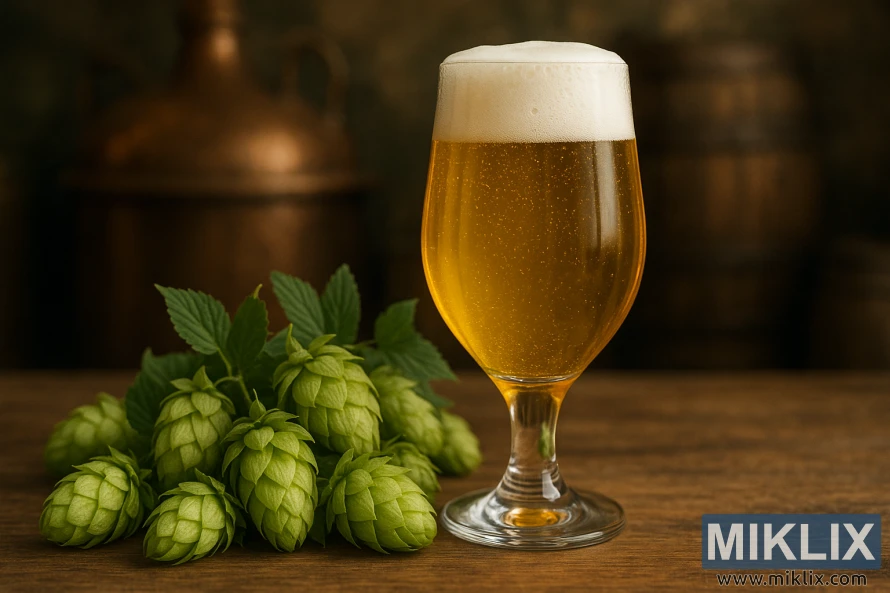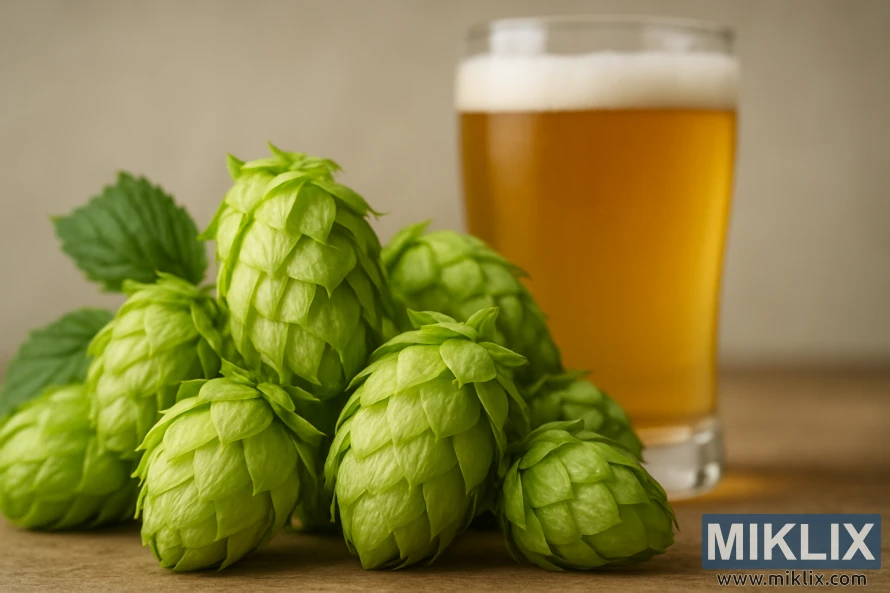Hops in Beer Brewing: Saaz
Published: July 31, 2025 at 11:36:41 AM UTC
Saaz hops have been a cornerstone in beer brewing for over a thousand years, mainly cultivated in the Czech Republic. Their rich history and distinct flavor profile have made them a favorite among brewers. Known for their delicate and complex characteristics, Saaz hops add earthy, floral, and spicy notes to beer. This article will explore the significance of Saaz hops in brewing and what brewers can expect when using them.

Key Takeaways
- Saaz hops are one of the oldest hop varieties used in brewing.
- They are known for their complex flavor profile.
- Saaz hops are mainly grown in the Czech Republic.
- Their unique characteristics make them ideal for certain beer styles.
- Understanding Saaz hops can enhance your brewing skills.
The Noble Heritage of Saaz Hops
Saaz hops, renowned for their noble traits, have been grown in the Czech Republic for over 400 years. This legacy profoundly impacts the brewing world, enriching beer brewing heritage.
Originating in the 16th century, Saaz hops quickly gained popularity in the Czech Republic. Their distinct flavor and aroma made them a staple in traditional Czech brewing.
The term "noble hops" refers to varieties with desirable traits like delicate aroma and flavor. Saaz hops, along with Hallertau, Tettnanger, and Spalt, are among the original noble hops. Their balanced alpha acid content and subtle character make them highly valued.
In the Czech Republic, Saaz hop cultivation is a cherished tradition. The region's unique soil and climate enhance Saaz hops' distinct qualities, making them sought after globally.
- Saaz hops are known for their delicate aroma and flavor profile.
- They are one of the four traditional noble hop varieties.
- Their cultivation is deeply rooted in Czech brewing traditions.
The noble heritage of Saaz hops reflects their historical importance and ongoing influence on brewing. As brewers innovate, Saaz hops remain essential, adding unique value to beer.
Understanding Saaz Hops Characteristics
For brewers aiming to craft high-quality beers, grasping the characteristics of Saaz hops is key. Saaz hops are celebrated for their delicate and complex flavor profile. This includes earthy notes, floral hints, and spicy undertones.
The flavor and aroma profile of Saaz hops are critical to their characteristics. These hops add a subtle yet distinctive flavor, enriching the brewing experience. The earthy notes add depth, while floral hints bring elegance to the beer.
Saaz hops have a relatively low alpha acid content, ranging from 2.5% to 4.5%. This makes them perfect for lager brewing, where a delicate flavor and aroma are sought. The low alpha acid content ensures the bitterness is balanced, not overwhelming the other flavors.
- Saaz hops offer a complex flavor profile with earthy, floral, and spicy notes.
- Their low alpha acid content makes them ideal for lager brewing.
- The delicate flavor and aroma of Saaz hops enhance the brewing experience.
Aside from their flavor and aroma, the chemical composition of Saaz hops, including beta acid content, is vital. Understanding these characteristics is essential for brewers to achieve the desired flavor and quality in their beers.

Chemical Composition and Brewing Properties
Saaz hops are celebrated for their unique chemical makeup, which significantly influences their brewing capabilities. With an alpha acid content between 2.5% and 4.5%, they are perfectly suited for lager brewing. This is because they impart a subtle bitterness that enhances the beer's flavor.
The beta acid content in Saaz hops is slightly higher, adding to the beer's distinct taste and aroma. The interplay between alpha and beta acids is key to the beer's overall character.
Saaz hops are also celebrated for their essential oils, which give them their distinctive aroma. The synergy between these oils and the hop's acid content results in a complex flavor profile. This is highly sought after in brewing circles.
- Low alpha acid content makes Saaz hops ideal for lager brewing.
- The beta acid content contributes to the unique flavor and aroma.
- Essential oils are responsible for the distinctive aroma of Saaz hops.
Grasping the chemical composition of Saaz hops is vital for brewers to fully exploit their capabilities. By understanding the subtleties of Saaz hops, brewers can craft a range of beer styles. These styles highlight the unique qualities of these hops.
Popular Beer Styles Featuring Saaz Hops
Saaz hops are essential in many traditional beer styles, most prominently in lager brewing. Their distinct flavor and aroma make them a key ingredient in specific lagers.
The Czech Pilsner is renowned for its crisp, refreshing taste and delicate hop flavor, which Saaz hops perfectly complement. The earthy, floral, and slightly spicy notes of Saaz hops balance the maltiness of the lager, resulting in a well-rounded beer.
Bohemian Pilsners also heavily rely on Saaz hops for their unique character. Known for their golden color, clear appearance, and subtle hop aroma, Saaz hops enhance the beer's flavor profile. They ensure a harmonious balance between hop and malt elements.
Saaz hops are also used in other lager styles where a subtle hop presence is desired. Their versatility and traditional use make them a favorite among brewers aiming for authentic, classic lagers.
The widespread use of Saaz hops in these beer styles highlights their quality and unique brewing characteristics. Whether brewing a traditional Czech Pilsner or exploring new lager recipes, Saaz hops are an excellent choice. They add depth and authenticity to your beer.

Brewing With Saaz Hops: Best Practices
To maximize the flavor and aroma of Saaz hops, brewers must adhere to specific guidelines. These hops can be added at different stages, including during the boil and as a dry hop. Knowing when and how to add them is key to achieving the desired flavor and aroma in your beer.
Adding Saaz hops during the boil requires careful timing. They are best added in the later stages to preserve their delicate aroma and flavor. This method prevents the loss of these characteristics during prolonged boiling.
Saaz hops can also be used as a dry hop to boost the beer's aroma. Dry hopping with Saaz hops adds a subtle, spicy, and floral character. The right amount is essential; too little may not provide enough flavor, while too much can unbalance the taste.
The dosage of Saaz hops varies based on the beer style and desired hop intensity. A moderate starting point is recommended, with adjustments made based on taste. The alpha acid content of the hops also affects the beer's bitterness and balance.
Some best practices for brewing with Saaz hops include:
- Using Saaz hops in beer styles where their unique characteristics can shine, such as Pilsners and other pale lagers.
- Adding Saaz hops in the later stages of the boil to preserve their aroma and flavor.
- Experimenting with dry hopping to enhance the beer's aroma.
- Carefully controlling the dosage to achieve the desired balance.
By following these best practices, brewers can effectively use Saaz hops to create high-quality beers. Whether brewing a traditional Pilsner or experimenting with new styles, Saaz hops are a valuable addition to your brewing repertoire.
Aroma and Flavor Contributions
Saaz hops introduce a unique character to beer, blending earthy, floral, and spicy notes. This distinct flavor profile is a cornerstone in traditional European lagers. It's favored for its delicate taste.
The aroma of Saaz hops is mild, with a hint of spice and flowers. They add a subtle complexity to beer, enriching its character without dominating it.
The flavor contributions of Saaz hops can be broken down into several key elements:
- Earthy undertones that add depth to the beer
- Floral notes that contribute to a subtle, refined taste
- Spicy hints that enhance the beer's complexity
By incorporating Saaz hops into their recipes, brewers can achieve a nuanced and balanced flavor profile. This is both authentic and refined. Whether used as a primary hop variety or blended with others, Saaz hops elevate any beer style.

Substitutes and Complementary Hop Varieties
Brewers often look for alternatives or complements to Saaz hops to create unique beer profiles. Hallertau and Tettnang are two popular options. They can enhance or substitute the flavor and aroma of Saaz hops.
Hallertau hops, from Germany, have a mild flavor and aroma similar to Saaz. They're great in European-style lagers, adding a spicy and floral note.
Tettnang hops, also from Germany, offer a balanced alpha acid content and refined aroma. They add a subtle hop flavor to beers without dominating the other ingredients.
When substituting Saaz hops with Hallertau or Tettnang, brewers must consider several factors. These include the alpha acid content, flavor and aroma profiles, and the brewing style. Understanding these aspects helps brewers create unique and complex beer profiles.
- The alpha acid content and bitterness level
- The flavor and aroma profiles
- The brewing style and beer type
Common Brewing Challenges with Saaz Hops
While Saaz hops bring distinct advantages, their use in brewing comes with its own set of challenges, mainly concerning hop utilization. Their delicate flavor and aroma can be lost if not handled correctly.
Optimizing hop utilization is a key challenge brewers face. This requires careful consideration of several factors. These include boil time, hop quantity, and dry-hopping techniques.
To tackle these challenges, brewers can employ best practices. Late hopping or dry-hopping can help retain Saaz hops' subtle flavors and aromas. Understanding the alpha acid content and specific brewing properties of Saaz hops is also essential for achieving the desired flavor profile.
By addressing these common brewing challenges, brewers can effectively use Saaz hops. This allows them to create high-quality beers that showcase the unique characteristics of this noble hop variety.
Harvesting and Processing Methods
Saaz hops are harvested and processed with great care to preserve their unique qualities. The harvesting happens in late summer, when the cones are fully ripe and the alpha acids are at their highest. This timing is key to capturing the hops' full flavor and aroma.
The harvesting process is meticulous, involving either hand-picking or mechanical picking to avoid damaging the hop cones. Once picked, the hops are transformed into various forms. These include pellets and whole cones, which brewers use in their craft.
The methods used to process Saaz hops aim to keep their delicate flavor and aroma intact. Common techniques include:
- Drying: To remove excess moisture and preserve the hops.
- Pelletizing: To compress the hops into convenient pellets for brewing.
- Whole cone processing: To maintain the hops in their natural state for traditional brewing methods.
The quality of Saaz hops greatly depends on how they are harvested and processed. Proper handling and processing ensure the hops retain their characteristic flavor and aroma. These are vital for creating high-quality beers.
In conclusion, the careful harvesting and processing of Saaz hops are essential for maintaining their quality and brewing performance. By understanding these methods, brewers can appreciate the craftsmanship that goes into producing these renowned hops.
Commercial Applications and Market Trends
Saaz hops are highly sought after in the craft beer sector due to their unique characteristics. The demand for these hops is fueled by the increasing popularity of craft beer, with a focus on lager brewing. Saaz hops are a traditional and preferred choice for this brewing style.
Saaz hops are used in various beer styles, but their application in lager brewing is most significant. Their mild, spicy flavor and aroma are key to the characteristic taste of many traditional European lagers. Their versatility also makes them suitable for other beer styles, where brewers aim to add a subtle hop flavor.
The market trend for Saaz hops is influenced by the overall growth of the craft beer industry. As craft breweries innovate and expand their product lines, the demand for high-quality, traditional hop varieties like Saaz remains strong. The trend towards using heritage and traditional ingredients in brewing has also boosted Saaz hops' popularity.
The craft beer industry's shift towards more traditional brewing methods and ingredients has positively impacted the demand for Saaz hops. This trend is expected to continue, with Saaz hops playing a vital role in the production of authentic, traditional beer styles.
In conclusion, Saaz hops are a vital component in the craft beer industry, with a significant role in lager brewing. Their unique characteristics, combined with the growing demand for craft beer, have driven their commercial applications and influenced market trends.
Organic vs. Conventional Saaz Cultivation
Organic and conventional cultivation represent two distinct approaches to growing Saaz hops. Each method has its own environmental and quality implications. The choice between them impacts not just the hops' brewing characteristics but also the sustainability of hop farming.
Organic Saaz cultivation eschews synthetic fertilizers, pesticides, and GMOs. This method fosters soil health, biodiversity, and water efficiency. It contributes to a sustainable agricultural ecosystem. Organic farming is seen as more environmentally friendly. It can produce hops with cleaner flavors, free from chemical residues.
Conversely, conventional Saaz cultivation may use synthetic fertilizers and pesticides to boost yield and combat pests. This approach can increase productivity and lower costs. Yet, it may harm the environment, leading to soil degradation and water pollution. Chemical residues on conventional hops can also alter their flavor and aroma.
The distinction between organic and conventional Saaz hops influences brewing outcomes and beer quality. Brewers opting for organic Saaz hops cater to consumers seeking environmentally friendly products with cleaner tastes. Those preferring conventional Saaz hops might value their consistency and cost-effectiveness.
- Organic Saaz cultivation promotes sustainable farming and reduces environmental impact.
- Conventional Saaz cultivation may offer higher yields but with environmental costs.
- The choice between organic and conventional Saaz hops can affect beer flavor and brewing practices.
In conclusion, the decision between organic and conventional Saaz cultivation hinges on balancing environmental sustainability, cost, and brewing needs. As demand for sustainable brewing ingredients rises, understanding these cultivation methods' implications becomes critical for brewers and consumers.
Recipe Development and Experimentation
Saaz hops bring a unique twist to various beer styles. When crafting a recipe, it's vital to think about how Saaz hops will enhance the beer's flavor and aroma.
Saaz hops are perfect for a wide range of beers, from lagers to ales. Their spicy and earthy flavors complement many malt profiles. This makes them a go-to choice for brewers looking to add depth to their brews.
- Classic Pilsner: Use Saaz hops for bittering, flavor, and aroma to create a traditional Czech-style Pilsner.
- Spiced Ale: Combine Saaz hops with spices like cinnamon and nutmeg for a unique winter warmer.
- Session Lager: Add Saaz hops towards the end of boiling to introduce a subtle floral note to a crisp, refreshing lager.
When experimenting, balancing bitterness, flavor, and aroma is key. The alpha acid content, usually between 3-5%, impacts bitterness levels.
Key points for recipe development include:
- Understanding the alpha acid content of Saaz hops and how it affects bitterness.
- Balancing the spicy and earthy flavors of Saaz hops with the malt profile.
- Experimenting with different boil times and hop additions to achieve the desired aroma and flavor.
By using Saaz hops in their recipes and experimenting with brewing techniques, brewers can craft a variety of innovative beers. These beers highlight the unique qualities of Saaz hops.
Conclusion
Mastering Saaz hops demands a deep grasp of their characteristics and brewing applications. Brewers can craft a variety of beers by leveraging Saaz hops' unique flavor and aroma. This allows them to showcase the hops' distinct qualities in their brews.
To excel with Saaz hops, brewers must be open to experimentation and refining their methods. By delving into the chemical makeup and brewing properties of Saaz hops, brewers can fully harness their capabilities. This leads to the creation of complex, balanced beers that are a true delight to the palate.
As you progress in your brewing endeavors, integrating Saaz hops into your recipes will enhance your understanding of their versatility. With dedication and persistence, you can master the art of brewing with Saaz hops. This will enable you to craft unique and delectable beers that honor their noble heritage.
Further Reading
If you enjoyed this post, you may also like these suggestions:
